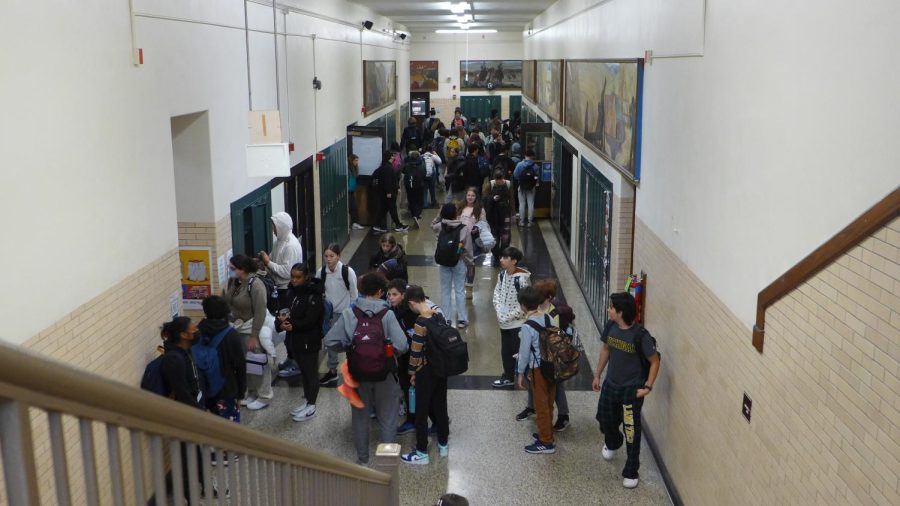For whom the bell tolls: Do you ever wonder, ‘Why a bell?’
Students exiting class after the bell rang
The school bell is accepted as the way that students know when class is over, but some find it loud or annoying. Everyone who has been at Lane while one grade level is taking a standardized test has been exposed to what an average day of school is like without bells. So why do schools still have bells?
One explanation for bells is historical, saying that bells were incorporated into schooling to make students more disciplined and dependent as a way to turn students into obedient and subservient workers. This is a part of a narrative around the origin of schooling that says our education system was made during the 19th-century industrial revolution as a way to convert people into factory workers.
“That’s not historically accurate,” Timothy Hopps, a social sciences teacher at Lane, said. “School bells have been used since the 18th century even in one-room schoolhouses and they always marked the start of the day and when it was time to go for lunch and then the end of the day.”
Despite its inaccuracies, this perspective is echoed in a lot of criticisms against the school system, including the widely circulated short video “I Sued the School System,” in which rapper Prince Ea says, “you were made to train people to work in factories” to a personification of the school system that he is putting on trial.
“It’s a narrative that people like because it makes sense because of what we know about factory work,” Hopps said. “But high school became popular and states started to require high school long after the industrial period.”
Bells weren’t put into schools with the intent to mold children into factory workers, but bells were put into schools and factories for some of the same reasons. In factories, bells served to remind workers of where they should be during the day and increase the efficiency and regimentation of the workday. When schools implemented bells, it was for similar reasons.
A major player in this movement was William Wirt, superintendent of Gary Public Schools from 1907-1938. The educational system Wirt introduced was known as the Gary Plan and focused on maximizing the efficient use of the school building. This led Wirt to use a bell to signal the beginning and end of class periods instead of just the beginning and end of the school day.
Bells were implemented because they had worked well as a way to make factory workers more punctual, and schools wanted children to be more punctual.
Bells signaling when to stop and resume class time make it easier for students to know what they’re supposed to be doing at a given moment.
“Punctuality is important,” Hopps said. “As a society, we believe that it’s disrespectful when someone starts to show up late, whether it’s outside of school or not. I think that’s something we should be teaching too. The bells help reinforce that.”
However, the hard-line in scheduling that bells bring to the table does not exist in college — or in many parts of the modern adult world.
“If you’re working in an office downtown — which is what a lot of students at Lane are going to end up doing — those sorts of jobs, the jobs of the 21st century, are a lot more flexible,” Hopps said.
While trying to alleviate the issues of volume, history, disruption, and practicality, schools across the country have explored a variety of alternatives to the school bell.
Thomas S. Wootton High School in Rockville, Md., went without bells for nine years from 2010-2019. Though they were initially concerned about teachers’ lessons going into the passing period, this was found to be a non-issue as the noise produced by the passing period was enough to make it clear when the period was over. The school eventually went back to bells a few years after the principal who started the tradition passed away.
Other institutions only remove the signature sound of the bell, maintaining the concept of a noise to signal changes in how to use your time. Rancho Mirage High in California is one of these institutions and has never used bells, instead using the sound of a rattlesnake three times a day: beginning, end and after lunch.
“Because my middle school didn’t have bells, it was more like ‘time’s up, go to your class,’” said Melat Gebreyus, a sophomore at Lane who went to Walt Disney Magnet School.
“I didn’t know it would be this loud,” Gebreyus said of Lane’s bell. “I came in [the] first day of school, first period, I was kinda scared of the bell, especially coming from a quiet environment at home [during remote learning].”
So what could the removal of bells look like at Lane?
Lane’s principal, Edwina Thompson, said that she would like it if music were played during passing periods. This music would replace bells, going from the time that the first bell would have rung to the time that the second bell would have rung. For the purpose of not drowning out conversation, the music wouldn’t be too loud or disruptive.
Amundsen already does something similar to what Thompson has proposed. The bells still ring, and they only play leading up to the bell similar to how the school song plays before first period every day at Lane. Looking at the process Amundsen went through to put their system into place provides some insight into how a similar system may function at Lane.
“It’s not all five minutes. I feel like that would be very annoying if it was all five minutes. It’s the last one minute to thirty seconds before the second bell,” said Santiago Salvador Vergara Wohlleb, who is a senior at Amundsen.
“It’s been a thing since the [20]19-[20]20 school year,” Vergara said. “It was very annoying when sometimes they wouldn’t change the song for months but now especially this year they’ve changed it every week.”
Regardless of whether or not Lane’s future comes with bells or not, any decision that might be made regarding them is important.
“How we structure a school day has implicit latent effects on what students learn … aside from what we’re teaching in our classes,” Hopps said.
Your donations directly fund the Lane Tech student journalism program—covering essential costs like website hosting and technology not supported by our school or district. Your generosity empowers our student reporters to investigate, write, and publish impactful stories that matter to our school community.
This website is more than a publishing platform—it's an archive, a research tool, and a source of truth. Every dollar helps us preserve and grow this resource so future students can learn from and build on the work being done today.
Thank you for supporting the next generation of journalists at Lane Tech College Prep!

Oliver is a senior in his first year with The Champion. He is a member of the Photography Club and Horror Movie Club. In his free time he enjoys spending...




